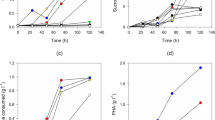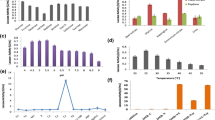Abstract
The effects of agitation and aeration rates on copolymer poly(3-hydroxybutyrate-co-3-hydroxyvalerate) [P(3HB-co-3HV)] production by Azohydromonas lata MTCC 2311 using cane molasses supplemented with propionic acid in a bioreactor were investigated. The experiments were conducted in a three-level factorial design by varying the impeller (150–500 rev min−1) and aeration (0.5–1.5 vvm) rates. Further, the data were fitted to mathematical models [quadratic polynomial equation and artificial neural network (ANN)] and process variables were optimized by genetic algorithm-coupled models. ANN and hybrid ANN-GA were found superior for modeling and optimization of process variables, respectively. The maximum copolymer concentration of 7.45 g l−1 with 21.50 mol% of 3HV was predicted at process variables: agitation speed, 287 rev min−1; and aeration rate, 0.85 vvm, which upon validation gave 7.20 g l−1 of P(3HB-co-3HV) with 21 mol% of 3HV with the prediction error (%) of 3.38 and 2.32, respectively. Agitation speed established a relative high importance of 72.19% than of aeration rate (27.80%) for copolymer accumulation. The volumetric gas–liquid mass transfer coefficient (k L a) was strongly affected by agitation and aeration rates. The highest P(3HB-co-3HV) productivity of 0.163 g l−1 h−1 was achieved at 0.17 s−1 of k L a value. During the early phase of copolymer production process, 3HB monomers were accumulated, which were shifted to 3HV units (9–21%) during the cultivation period of 24–42 h. The enhancement of 7.5 and 34% were reported for P(3HB-co-3HV) production and 3HV content, respectively, by hybrid ANN-GA paradigm, which revealed the significant utilization of cane molasses for improved copolymer production.








Similar content being viewed by others
References
Almeida AD, Giordano AM, Nikel PI, Pettinari MJ (2010) Effects of aeration on the synthesis of poly(3-hydroxybutyrate) from glycerol and glucose in recombinant Escherichia coli. Appl Environ Microbiol 76:2036–2040
Baei MS (2009) Optimization of PHAs production from cheese whey by Azohydromonas lata. New Biotechnol 25:S268
Bandaiphet C, Prasertsan P (2006) Effect of aeration and agitation rates and scale-up on oxygen transfer coefficient, K L a in exopolysaccharide production from Enterobacter cloacae WD7. Carbohydr Polym 66:216–228
Beaulieu M, Beaulieu Y, Melinard J, Pandian S, Goulet J (1995) Influence of ammonium salts and cane molasses on growth of Alcaligenes eutrophus and production of polyhydroxybutyrate. Appl Environ Microbiol 61:165–169
Caldeira AT, Arteiro JM, Roseiro JC, Neves J, Vicente H (2011) An artificial intelligence approach to Bacillus amyloliquefaciens CCMI 1051 cultures: application to the production of anti-fungal compounds. Bioresour Technol 102:1496–1502
Carter IS, Dawes EA (1979) Effects of oxygen concentration and growth rate on glucose metabolism, poly-β-hydroxybutyrate biosynthesis and respiration of Azotobacter beijerinckii. J Gen Microbiol 110:393–400
Castilho LR, Mitchell DA, Freire DMG (2009) Production of polyhydroxyalkanoates (PHAs) from waste materials and by-product by submerged and solid-state fermentation. Bioresour Technol 100:5996–6009
Chen G-Q, Konig K-H, Lafferty RM (1991) Production of poly-D(-)-3-hydroxybutyrate and poly-D(-)-3-hydroxyvalerate by strains of Alcaligenes latus. Antonie van Leeuwenhoek 60:61–66
Demirtas MU, Kolhatkar A, Kilbane II JJ (2003) Effect of aeration and agitation on growth rate of Thermus thermophilus in batch mode. J Biosci Bioeng 95:113–117
Desai KM, Survase SA, Saudagar PS, Lele SS, Singhal RS (2008) Comparison of artificial neural network (ANN) and response surface methodology (RSM) in fermentation media optimization: case study of fermentative production of scleroglucan. Biochem Eng J 41:266–273
Doran PM (1995) Bioprocess engineering principles. Academic Press, New York
Feng Y, He Z, Ong SL, Hu J, Zhang Z, Ng WJ (2003) Optimization of agitation, aeration, and temperature conditions for maximum β-mannanase production. Enzym Microbiol Technol 32:282–289
Franco-Lara E, Link H, Weuster-Botz D (2006) Evaluation of artificial neural networks for modeling and optimization of medium composition with a genetic algorithm. Process Biochem 41:2200–2206
Gouda MK, Swellam AE, Omar SH (2001) Production of PHB by a Bacillus megaterium strain using sugarcane molasses and corn steep liquor as sole carbon and nitrogen sources. Microbiol Res 156:201–207
Grothe E, Moo-Young M, Chisti Y (1999) Fermentation optimization for the production of poly (β-hydroxybutyric acid) microbial thermoplastic. Enzym Microb Tech 25:132–141
Khoo LP, Chen CH (2001) Integration of response surface methodology with genetic algorithms. Int J Adv Manuf Technol 18:483–489
Kim YB, Lenz RW (2000) Polyester from microorganism. In: Scheper T (ed) Advances in Biochemical Engineering/Biotechnology: Biopolyester. Springer, Berlin Heidelberg New York, pp 52–77
Kumar S, Zafar M, Prajapati JK, Kumar S, Kannepalli S (2011) Modeling studies on simultaneous adsorption of phenol and resorcinol onto granular activated carbon from simulated aqueous solution. J Hazard Mater 185:287–294
Kumkarni SO, Kanekar PP, Nilegaonkar SS, Sarnaik SS, Jog JP (2010) Production and characterization of a biodegradable poly (hydroxybutyrate-co-hydroxyvalerate) (PHB-co-PHV) copolymer by moderately haloalkalitolerant Halomonas campisalis MCM B-1027 isolated from Lonar Lake, India. Bioresour Technol 101:9765–9771
Lee KM, Gilmore DG (2005) Formulation and process modeling of biopolymer (Polyhydroxyalkanoates: PHAs) production from industrial wastes by novel crossed experimental design. Process Biochem 40:229–246
Lee SY (1996) Bacterial polyhydroxyalkanoates. Biotechnol Bioeng 49:1–14
Mantzouridou F, Roukas T, Kotzekidou P (2002) Effect of the aeration rate and agitation speed on β-carotene production and morphology of Blakeslea trispora in a stirred tank reactor: mathematical modeling. Biochem Eng J 10:123–135
Marangoni C, Furigo A, Gla′ucia MFA (2002) Production of poly(3-hydroxybutyrate-co-3-hydroxyvalerate) by Ralstonia eutropha in whey and inverted sugar with propionic acid feeding. Process Biochem 38:137–141
Marchessault RH, Yu G (2004) Crystallization and material properties of polyhydroxyalkanaotes. In: Steinbüchel A (ed) Biopolymers, vol 3b. Wiley, New York, pp 157–170
Posada JA, Naranjo JM, Lopez JA, Higuita JC, Cardona CA (2011) Design and analysis of poly-3-hydroxybutyrate production processes from crude glycerol. Process Biochem 46:310–317
Potumarthi R, Subhakar C, Jetty A (2009) Alkaline protease production by submerged fermentation in stirred tank reactor using Bacillus licheniformis NCIM-2042: effect of aeration and agitation regimes. Biochem Eng J 34:185–192
Purushothaman M, Anderson RKI, Narayana S, Jayaraman VK (2001) Industrial byproducts as cheaper medium components influencing the production of polyhydroxyalkanaotes (PHA)-biodegradable plastics. Bioprocess Biosys Eng 24:131–136
Rajasekaran S, Pai GAV (2010) Neural networks, fuzzy logic, and genetic algorithms: synthesis and applications. PHI Learning Pvt. Ltd., New Delhi, pp 305–327
Rao DS, Panda T (1994) Critical analysis of the effect of metal ions on gluconic acid production by Aspergillus niger using a treated Indian cane molasses. Bioprocess Eng 10:99–107
Rech FR, Volpato G, Ayub MAZ (2011) Optimization of lipase production by Staphylococcus warneri EX17 using the polydimethylsiloxanes artificial oxygen carriers. J Ind Microbiol Biotechnol 38:1599–1604
Riis V, Mai W (1988) Gas chromatographic determination of poly-β-hydroxybutyric acid in microbial biomass after hydrochloric acid propanolysis. J Chrom 445:285–289
Sangkharak K, Prasertsan P (2007) Optimization of polyhydroxybutyrate production from a wild-type and two mutant strains of Rhodobacter spheeroides using statistical method. J Bacteriol 132:331–340
Sivapathasekaran C, Mukherjee S, Ray A, Gupta A, Sen RK (2010) Artificial neural network modeling and genetic algorithm based medium optimization for the improved production of marine biosurfactant. Bioresour Technol 101:2884–2887
Solaiman DKY, Ashby RD, Hotchkiss AT, Foglia TA (2006) Biosynthesis of medium-chain-length poly (hydroxyalkanoates) from soy molasses. Biotechnol Lett 28:157–162
Solozano L (1969) Determination of ammonia in natural waters by the phenol hypochlorite method. Limnol Oceanogr 14:799–801
Sudesh K, Abe H, Doi Y (2000) Synthesis, structure and properties of Polyhydroxyalkanoates: biological polyesters. Prog Polm Sci 25:1503–1555
Thammawong C, Thongkhong K, Iamtassana K, Sharp A, Opaprakasit P (2008) Production and characterization of polyhydroxyalkanoates (PHAs) from inexpensive substrates by Alcaligens latus. Adv Mat Res 55–57:893–896
Wang F, Lee SY (1997) Poly (3-Hydroxybutyrate) production with high productivity and high polymer content by a Fed-batch culture of Alcaligenes latus under nitrogen limitation. Appl Environ Microbiol 63:3703–3706
Wang J, Wan W (2009) Optimization of fermentative hydrogen production process using genetic algorithm based on neural network and response surface methodology. Int J Hydrogen Energy 34:255–261
Weuster-Botz D (2000) Experimental design for fermentation media development: statistical design or global random search? J Biosci Bioeng 90:473–483
Wong PAL, Chua H, Lo W, Lawford HG, Yu PH (2002) Production of specific copolymers of polyhydroxyalkanoates from industrial waste. Appl Biochem Biotechnol 98–100:655–662
Xie C-H, Yokota A (2005) Reclassification of Alcaligenes latus strains IAM 12599T and IAM 12664 and Pseudomonas saccharophila as Azohydromonas lata gen. nov., comb. nov., Azohydromonas australica sp. nov. and Pelomonas saccharophila gen. nov., comb. Nov., respectively. Int J Syst Evol Microbiol 55:2419–2425
Yamane T (1993) Yield of poly-D(-)-3-hydroxybutyrate from various carbon sources: a theoretical study. Biotechnol Bioeng 41:165–170
Zafar M, Kumar S, Kumar S (2010) Optimization of naphthalene biodegradation by a genetic algorithm based response surface methodology. Braz J Chem Eng 27:89–99
Zafar M, Kumar S, Kumar S, Dhiman AK (2012) Optimization of polyhydroxybutyrate (PHB) production by Azohydromonas lata MTCC 2311 by using genetic algorithm based on artificial neural network and response surface methodology. Bio Agri Biotech 1:70–79. doi:10.1016/j.bcab.2011.08.012
Zafar M, Kumar S, Kumar S, Dhiman AK (2012) Artificial intelligence based modeling and optimization of poly(3-hydroxybutyrate-co-3-hydroxyvalerate) production process by using Azohydromonas lata MTCC 2311 from cane molasses supplemented with volatile fatty acids: a genetic algorithm paradigm. Bioresour Technol 104:631–641
Acknowledgments
One of us (Mr. Mohd.Zafar) is thankful to the Ministry of Human Resources and Development, Govt. of India, New Delhi, for providing him a fellowship.
Author information
Authors and Affiliations
Corresponding author
Rights and permissions
About this article
Cite this article
Zafar, M., Kumar, S., Kumar, S. et al. Modeling and optimization of poly(3hydroxybutyrate-co-3hydroxyvalerate) production from cane molasses by Azohydromonas lata MTCC 2311 in a stirred-tank reactor: effect of agitation and aeration regimes. J Ind Microbiol Biotechnol 39, 987–1001 (2012). https://doi.org/10.1007/s10295-012-1102-4
Received:
Accepted:
Published:
Issue Date:
DOI: https://doi.org/10.1007/s10295-012-1102-4




